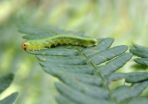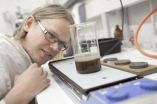(Press-News.org) Stretching across central Africa, the Congo Basin forest is the second largest tract of rainforest in the world and a lifeline for more than 60 million people – providing food and income for many remote communities, storing huge amounts of carbon, supporting unique ecosystems and regulating the flow of the major rivers across Central Africa. Yet the Congo's forests are being cleared at an alarming rate amid global demand for the continent's minerals, energy and wood resources. Current methods and rates of extracting these resources are unsustainable and threatening the future of the forest, and the people who rely on it.
As the Congo Basin is threatened, more research is needed to help protect the forest. The Center for International Forestry Research (CIFOR) is currently supporting a new generation of researchers and working to improve the management of the Congo Basin forest and address the needs and perspectives of the people who depend on the forest for their livelihoods.
Media are invited to use a series of 11 colourful feature stories, nine videos and hundreds of photographs from Cameroon and the Democratic Republic of Congo, exploring some of the threats facing the Congo Basin, and efforts by communities, governments, scientists and NGOs to address those threats.
Issues covered include:
Under Threat: Deforestation pressure on Congo Basin forests increasing
The Congo Basin forest is a lifeline for more than 60 million people. It generates income from timber exploitation, stores huge amounts of carbon, supports unique ecosystems, and regulates the flow of the major rivers across Central Africa. Yet the forest is being cleared at an alarming rate amid global demand for its mineral, energy and wood resources.
Young Leaders: The future of the Congo's forestry research
From elephant shrews to ecosystems, Congolese Masters and PhD students at the University of Kisangani in the Democratic Republic of the Congo are unravelling the mysteries of their country's vast forests.
Taming Okok: Domesticating forest foods in Cameroon
Demand for Okok, a leafy vine found across the Congo Basin, is outstripping supply. To counter the increasingly unsustainable harvest, villagers in Cameroon are establishing plantations of the vine inside the forest.
Up the river and paddling hard: Linking climate change adaptation and mitigation in the Congo Basin
People in the remote town of Lukolela – 540 km from Kinshasa on the Congo River in the Democratic Republic of Congo – are already feeling the effects of climate change. But with the help of a new CIFOR project, they're planning ways to reduce its impact on their daily lives.
Bushmeat Stories: Voices from the Congo Basin
Hunters, traders, scientists and conservationists all view bushmeat differently. But they all agree on one thing – the animals are disappearing.
Cutting through: Formalising Cameroon's huge domestic timber market
New research has revealed that Cameroon's domestic, informal timber market is as large as the country's industrial export market. The Government is now trying to bring rural chainsaw loggers and traders into the fold and formalise the huge sector.
Counting carbon: Measuring carbon stocks in logging concessions in Cameroon
Scientists in Cameroon are hoping to bolster scientific evidence that shows sustainable timber production in forests logged by private companies and local communities could increase carbon stocks – thus reducing the greenhouse gas emissions that contribute to global warming.
### To see the full package of photos, stories and videos in English and French, visit http://blog.cifor.org/congo
The multimedia package was produced by writer and video journalist Kate Evans, writer Babatope Aramide Akinwande, and photographer Ollivier Girard for the Center for International Forestry Research.
All stories were produced with Creative Commons Attribution-Non-commercial-Share Alike License. Media are welcome to use them as long as they are attributed correctly. High definition versions of the films can be made available upon request.
The Center for International Forestry Research (CIFOR) advances human wellbeing, environmental conservation and equity by conducting research to inform policies and practices that affect forests in developing counties. CIFOR helps ensure that decision-making that affects forests is based on solid science and principles of good governance, and reflects the perspectives of developing countries and forest-dependent people. CIFOR is one of 15 members of the CGIAR Consortium.
www.cifor.org
www.blog.cifor.org
To see the full package of photos, stories and videos in English and French, visit http://blog.cifor.org/congo
TORONTO, Nov. 21, 2012-- New research has found there are several different ways that kidney tumours can achieve the same result – namely, grow.
Scientists have been trying to figure out how different people have kidney tumours with the same histology, or shape, although the genetic changes can vary among individual tumours.
Solving that puzzle could have implications for the diagnosis and treatment if kidney cancer, which has 35 per cent mortality rate and is becoming more common. Despite advances in early detection and treatment, the mortality rate hasn't changed in ...
Published in the Comunicación journal, a study conducted by the University of Seville analyses violence content in Spanish TV series. It concludes that Telecinco's Sin tetas no hay paraíso is the most violent of the five studied.
Despite the fact that other series have more scenes or minutes of violence, according to the study, the Telecinco series is more powerful in its transmission of values that are more detrimental to youngsters in terms of their perception of aggressive behaviour and its consequences.
Sara González, the author of the study, explains to SINC ...
A consortium of researchers led by WMG at the University of Warwick are to embark on a £3 million research programme called "Cleaning Land for Wealth" (CL4W), that will use a common class of flower to restore poisoned soils while at the same time producing perfectly sized and shaped nano sized platinum and arsenic nanoparticles for use in catalytic convertors, cancer treatments and a range of other applications.
A "Sandpit" exercise organised by the Engineering and Physical Sciences Research Council (EPSRC) allowed researchers from WMG (Warwick Manufacturing group) at ...
In order to find out about its migrations, various research centres in South Africa, Sweden, Canada, Chile, Australia, Spain, Argentina and Switzerland have conducted research detailing its routes and expansion periods. A significant new fact has emerged and it is that the wasps returning to Europe from Chile and South Africa have undergone a genetic micro-evolution which makes them more resistant to their natural European enemy, a nematode that sterilises them.
The Sirex noctilio wasp is regarded as a secondary pest in Europe because in this geographical area there is ...
"Methods are required that take the social and environmental impacts of business operations better into account, both within the company and among its network of partners and stakeholders," says Uusitalo. "If a change cannot be effected, the current unsustainable way of life will continue, and we might also miss some opportunities for creating new business. Market share is at stake here."
According to Uusitalo, other companies and customers demand that companies take a wider view of sustainable development.
"Legislation will also inevitably lead development in this ...
This press release is available in German.
They dominated the earth for 200 million years and numerous different species can still be found all over the world: mosses, horsetails and ferns. Researchers from the Max Planck Institute for Chemical Ecology in Jena, Germany, have now found out that bracken ferns (Pteridium aquilinum) do not release any volatiles when they are attacked − unlike many of the now dominant and evolutionary younger flowering plants. Such an emission of volatile compounds may attract the pest insects' enemies, such as ichneumon wasps or ...
Researchers at Aalto University have developed a simple method for reducing the amount of phosphorus in the wastewater of a pulp mill. The method is called simultaneous precipitation using iron sulphate. A separate treatment stage is not required, as the precipitation takes place simultaneously with the actual biological wastewater treatment.
Iron sulphate is added to the wastewater prior to the biological wastewater treatment process, and the phosphorus dissolved into the water is precipitated with the biomass at the treatment plant. Finally, the phosphorus is removed ...
Trust rather than lust is at the heart of the attention to detail and finely made form of handaxes from around 1.7 million years ago, according to a University of York researcher.
Dr Penny Spikins, from the Department of Archaeology, suggests a desire to prove their trustworthiness, rather than a need to demonstrate their physical fitness as a mate, was the driving force behind the fine crafting of handaxes by Homo erectus/ergaster in the Lower Palaeolithic period.
Dr Spikins said: "We sometimes imagine that early humans were self-centred, and if emotional at all, that ...
CAMBRIDGE, MA -- Each winter, wide swaths of the Arctic Ocean freeze to form sheets of sea ice that spread over millions of square miles. This ice acts as a massive sun visor for the Earth, reflecting solar radiation and shielding the planet from excessive warming.
The Arctic ice cover reaches its peak each year in mid-March, before shrinking with warmer spring temperatures. But over the last three decades, this winter ice cap has shrunk: Its annual maximum reached record lows, according to satellite observations, in 2007 and again in 2011.
Understanding the processes ...
CLEVELAND, Ohio (November 21, 2012)—Moving 6,000 or more steps a day—no matter how—adds up to a healthier life for midlife women. That level of physical activity decreases the risk of diabetes and metabolic syndrome (a diabetes precursor and a risk for cardiovascular disease), showed a study published online this month in Menopause, the journal of the North American Menopause Society.
Although other studies have shown the value of structured exercise in lowering health risks such as diabetes, high blood pressure, and heart disease, this study has shown that habitual physical ...


